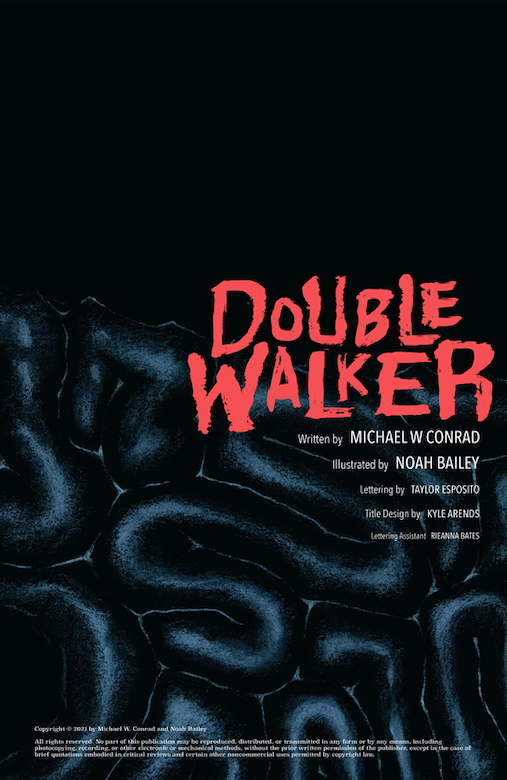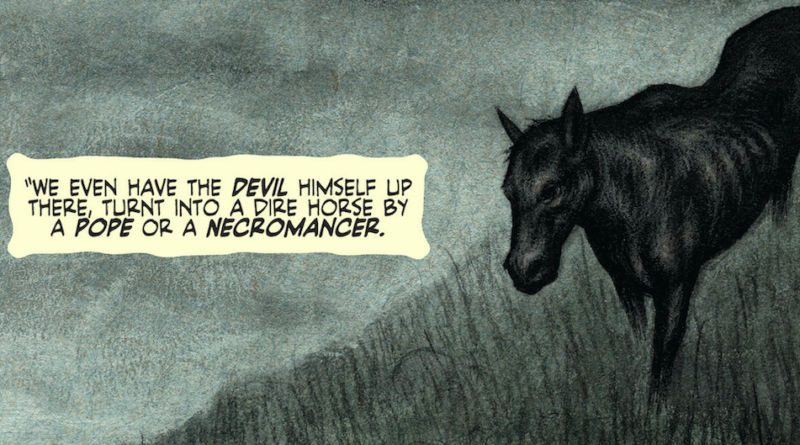INTERVIEW: ‘Double Walker’ graphic novel finds inspiration in Scottish Highlands
Image courtesy of comiXology / Provided with permission.
The new graphic novel Double Walker, the brainchild of writer Michael W. Conrad and artist Noah Bailey, finds a married couple heading to the Scottish Highlands for one more trip before they welcome a baby into this world. What they find in the northern reaches of the country scares them to the bone. At a local pub, they hear stories of Scottish myths and murders in the local town, and soon their own fate is intertwined with the unsettling stories being spun in this tucked-away watering hole.
The new graphic novel comes courtesy of comiXology, the leading publisher of online comics. The project serves as the followup to Conrad and Bailey’s last graphic novel, Tremor Dose.
Comic book fans should know the work of Conrad and Bailey. Conrad is currently co-writing Wonder Woman and Midnighter for DC, while Bailey is best known for his cinema-inspired multimedia work, according to their official biographies. Recently Hollywood Soapbox exchanged emails with both creators about Double Walker. Questions and answers have been slightly edited for style.
What do you like the most about your central characters of Cully and Gemma?
CONRAD: Cully genuinely seems like he means well. He is flawed and silly, and in many ways I identify with that. Depending on how well someone knows me, these elements might be the only parts of me they ever get to know. It’s a bit of a cover for the boiling introspection that goes on in my head — anxiety, fear, obsession. It’s just easier to present as a dork sometimes.
Gemma is in some ways a more compelling character to me because we are only aware of certain elements of her character. Gemma is the kind of person that you want to spend time with. She’s smart, compassionate and supportive. There is more to her: She has dreams, interests and goals. The nature of the story makes these harder to identify. If we did our job well, readers will wish they knew her better, and even in their ignorance of these things, they will want the best for her.
BAILEY: At the beginning, I love Cully and Gemma as a team. They have their individual strengths and weaknesses, likes and dislikes, future goals and pasts, but they are devoted to each other’s growth and well-being, as a unit and independently of one another. I really enjoy building the history for each character, no matter how loathsome or awful. It’s important to me to understand the actions and reactions that allowed each character to arrive at the point where we meet them. Cully is, in my mind, a somewhat reformed country club kid who found a love for creative writing and became very open-minded while in college. Gemma was that very shy, sweet punk girl with braces for what seemed like a lifetime, and always had a very curious mind. They crossed paths at the right time in their adult lives and found each other to be the unexpected other-half to their story!
Why set the book in the Scottish Highlands? What is it about this part of the world that can prove so scary?
CONRAD: I took a trip similar to the one that Cully and Gemma go on in Double Walker and immediately knew I wanted to use the area in a book. As an American visitor I was blown away by the beauty and mystery presented by the land and culture. For this story, it is just removed enough and provided a bit of displacement for many readers, that it served as a perfect place to explore fear.
BAILEY: For me, never having been to the Highlands, it seems to be a very mysterious and beautiful place that holds some potentially dangerous powers for any overly-intrusive visitor. With all of the research I’ve done, I would be very careful to heed the warnings of the folklore and tread lightly if I am ever fortunate enough to visit.
Is writing / illustrating horror difficult? Are you aware when content feels scary or not scary enough?
CONRAD: Writing horror for comics is hard because it’s tempting to lean too heavily on the artist to make it happen. I knew I had a deadly weapon in Noah, but I didn’t want to rely simply on his ability to disturb. As the writer I attempted to do so with pacing and withholding. The darkness is always the scary part, so we made sure to let the reader have space to consider what may be hidden.
BAILEY: I think horror is a really difficult genre to tackle in comics. It’s pretty easy to create a horrifying image, but to build and maintain the tension required over the length of a graphic novel is a lot more work. Luckily, Michael knows how to construct a horrifying narrative like no other, and it was all pretty much right there for me. The biggest challenge is finding that happy medium of showing enough, but not too much. I’m eager to work more in that realm and get deeper into what makes a comics narrative truly bone-chilling.
How did you two work together? What was the working relationship like?
CONRAD: Everything starts with a conversation. The conversation often lasts for the entirety of the creative act. Ultimately we both work alone, but along the way we check in routinely, ask questions, give notes, all of that. We balance this by allowing each other agency over the decisions relative to our responsibilities. For me that meant not overdirecting the script. I know Noah well enough to understand that he has the ability to make great and often terrifying choices.
BAILEY: I think Michael and I have a mutual trust and respect for each other as collaborators. If he has an idea that I love, and I want to give him a sense of the tone that I want to achieve with the imagery, I’ll suggest some films and some music for him to check out while he’s writing. But I never want to directly influence his creative flow, and I am never disappointed!
Did you ever consider these stories and characters for a traditional comic book, or was it a graphic novel from the start?
CONRAD: We built the story in five 25-page chunks. Our vision was for the book to exist, either as a miniseries or a graphic novel. This didn’t change how I approached the script, as we knew a story like this was all or nothing. If it was a miniseries, no one would be jumping in at part 3, so doing it in chunks also provided opportunities for us to review and discuss.
It’s just Noah and I. We have no editor on this, and I didn’t share the script with anyone but Noah. Having pauses in the action to ask, “Am I losing it, or is this good?” was really important for me.
BAILEY: Yeah, we planned it to work as one big book or five single issues. I had a series of covers planned if we were to do it as a miniseries, and I would still really like to do those in the future. Maybe we can make that happen for the printed edition!
Do you think there are more adventures to be had with Double Walker?
CONRAD: At the moment our interest is in allowing this to be digested. It stands alone really well, so I doubt there is much to say beyond what has been shown. I have ideas set in the area, perhaps things that may be connected to Double Walker in spirit, but we’ll see if we get to that. We have a lot of stories we’d like to tell, so it depends on what excites us most.
BAILEY: I think that Double Walker is a standalone story that I am very proud of, and I’m not sure that I would want to potentially disturb its integrity with a sequel. I am a bit in love with Scotland and Scottish folklore at this point though, and I think we both feel as though there is some unfinished business for us in that world.
By John Soltes / Publisher / John@HollywoodSoapbox.com
Double Walker, written by Michael W. Conrad and illustrated by Noah Bailey, is now available from comiXology. Click here for more information.


